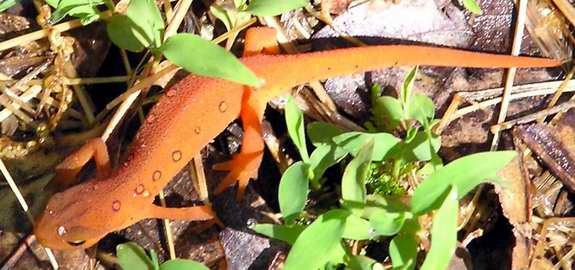|
Common Name: Red Eft, Red Spotted Newt (newt comes originally from "an eft" which became "a neft" with "w" eventually replacing "f" in common usage) Scientific Name: Notophthalmus viridescens The red eft is frequently seen on the trail in the spring after a rainfall when the underbrush is moist. They are easily recognized by their bright orange-red color with porthole like darker red spots arrayed longitudinally along the flanks. Potpourri: The red eft is the terrestrial juvenile stage of the red spotted newt. The life cycle of the newt consists of three stages. The eggs are hatched in water as larval salamanders with prominent finned tails and external gill tufts. The larvae metamorphose into the second terrestrial red eft phase with fully developed lungs in the place of gills. After three to seven years, the eft is transformed into a third phase as an aquatic, green-colored adult for the remainder of its life, spawning the next generation. The three year terrestrial eft stage is an adaptation for dispersal. As newts are pond dwellers, overcrowding would result without a means for expansion. The eft has the ability to move to new ponds, thus establishing new colonies and contributing to the survival of the species. The red coloration is unique to the terrestrial phase of the newt's life cycle and is thought to serve as a warning sign to would-be predators that the eft's skin exudes toxic substances that are unpalatable. Red salamanders have similar coloration as mimicry. |
